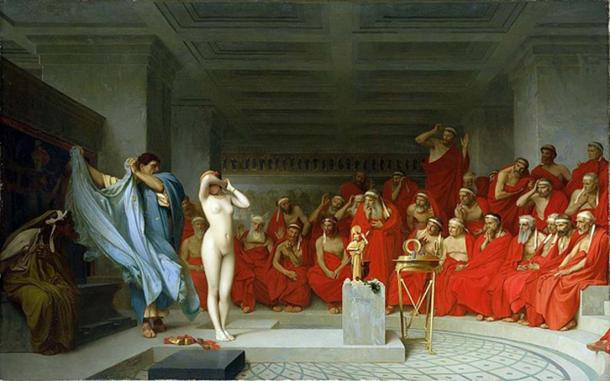Phryne, The Ancient Greek Prostitute Who Flashed Her Way to Freedom
Phryne the Thespian was a famed courtesan of Athens, better known for the court case she won by baring her breasts. Her actual name was Mnesarete but people referred to her as Phryne (“toad”) because of the yellow complexion of her skin.
Early life and Claim to Fame
Phryne was the daughter of Epicles from Thespiae (Boeotia), but spent most of her life in Athens. Even though we don’t know the exact dates of her birth and death, various historians estimate that she was born around 371 BC, the year Thebes razed Thespiae not long after the battle of Leuctra and expelled its inhabitants.
Thanks to her extraordinary beauty, she became a model posing for various painters and sculptors, including the great Praxiteles (who was also one of her clients). Actually, Praxiteles’s statue of Phryne was purchased by the city of Cnidus – after the city of Cos that had originally commissioned it, objected to its being nude – and became such a popular tourist attraction that the city managed to pay off its entire debt.

Cnidus Aphrodite. Marble, Roman copy after a Greek original of the 4th century. (Marie-Lan Nguyen/ CC BY 2.5 ) Phryne is said to be the model of the original.
Phryne’s beauty also became the subject of many ancient Greek scholars, who praised her good looks, with Athenaeus providing the most details about Phryne’s life. He mentions in his work titled The Deipnosophists,
“Phryne was a really beautiful woman, even in those parts of her person which were not generally seen: on which account it was not easy to see her naked; for she used to wear a tunic which covered her whole person, and she never used the public baths. But on the solemn assembly of the Eleusinian festival, and on the feast of the Poseidonia, then she laid aside her garments in the sight of all the assembled Greeks, and having undone her hair, she went to bathe in the sea; and it was from her that Apelles took his picture of Aphrodite Anadyomene; and Praxiteles the sculptor, who was a lover of hers, modelled the Aphrodite of Cnidus from her body; and on the pedestal of his statue of Eros, which is placed below the stage in the theatre, he wrote the following inscription:
Praxiteles has devoted earnest care
To representing all the love he felt,
Drawing his model from his inmost heart:
I gave myself to Phryne for her wages,
And now I no more charms employ, nor arrows,
Save those of earnest glances at my love.”
Phryne at the Poseidonia in Eleusis. (1889) By Henryk Siemiradzki. ( Public Domain )
Phryne’s Extreme Wealth
Athenaeus also recorded that Phryne was possibly the richest self-made woman of her time. She became so vastly rich at some point of her life that she offered to fund the rebuilding of the walls of Thebes, which had been destroyed by Alexander the Great in 336 BC. She demanded that the words “Destroyed by Alexander, restored by Phryne the courtesan” would be inscribed on the walls. Intimidated of the idea that a woman – and for that matter not just any woman, but a prostitute – could rebuild what Alexander the Great had destroyed, Phryne’s offer was rejected by the town’s patriarchs and the walls remained in ruin.
Phryne’s Trial
Despite her “divine” looks, incredible wealth, and famous lovers, what immortalized Phryne in the history books is undoubtedly her famous trial. Athenaeus writes that she was prosecuted for a capital charge and defended by the orator Hypereides, who was one of her lovers. He does not specify the nature of the charge, though some unverified historical sources ( Pseudo-Plutarch) mention that she was accused of impiety.
- Theodora: From humble beginnings to powerful empress who changed history
- The Four Great Beauties, and the Arts of the Courtesans in Ancient China
- Pleasure, Procreation, and Punishment: Shocking Facts about Sex and Marriage in the Ancient World

Sculptor Praxiteles offering a statue of Cupid (his favorite work) as a gift to Phryne. (1794) By Angelica Kauffman. ( Public Domain )
Even though there’s a great dispute among historians about what really happened that day in the court, one of the most credible sources (that of Athenaeus) states that Hypereides tore off Phryne’s robes in the middle of the courtroom to show the judges her beautiful breasts. His reasoning was that only the Gods could sculpt a body so perfect and as such, killing or imprisoning her would be seen as blasphemy and disrespect to the Gods. Athenaeus mentions in The Deipnosophists,
“Now Phryne was a native of Thespiae; and being prosecuted by Euthias on a capital charge, she was acquitted: on which account Euthias was so indignant that he never instituted any prosecution afterwards, as Hermippus tells us. But Hypereides, when pleading Phryne’s cause, as he did not succeed at all, but it was plain that the judges were about to condemn her, brought her forth into the middle of the court, and, tearing open her tunic and displaying her naked bosom, employed all the end of his speech, with the highest oratorical art, to excite the pity of her judges by the sight of her beauty, and inspired the judges with a superstitious fear, so that they were so moved by pity as not to be able to stand the idea of condemning to death “a prophetess and priestess of Aphrodite.” And when she was acquitted, a decree was drawn up in the following form: “That hereafter no orator should endeavour to excite pity on behalf of any one, and that no man or woman, when impeached, shall have his or her case decided on while present.”
Phryne before the Areopagus. (1861) By Jean-Léon Gérôme. ( Public Domain )
Verdict and Legacy of Phryne’s Trial
What seemed as a lost case for Phryne, turned quickly into a triumph for her after the inspired act by Hypereides. Phryne walked out the court victorious and her story went on inspiring several works of art, including the painting Phryne before the Areopagus by Jean-Léon Gérôme, from 1861, the 1904 painting Phryne, by José Frappa; the sculpture Phryné by French sculptor Alexandre Falguière; and the sculpture Phryne Before the Judges , by the American sculptor Albert Weine, from 1948. More importantly, the famous hetaerae is seen by some scholars today as a symbol of freedom against repression disguised as piety, even though most of us will probably agree that some of her choices in life weren’t the most ideal or moral for a lady.

Related Post
A shocking documentary proves that mermaids do exist
SHOCKING Revelation: Thuya, Mother of Queen Tiye, Was the Grandmother of Akhenaten and Tutankhamun—What Ancient Egyptian Secrets Did She Leave Behind?
Breaking News: Astonishing Discoveries at Karahan Tepe Confirm an Extraterrestrial Civilization is Hiding on Earth, and NO ONE Knows!
Breaking News: Researchers FINALLY Discover U.S. Navy Flight 19 After 75 Years Lost in the Bermuda Triangle!
NASA’s Secret Investigation: Uncovering the Astonishing Mystery of the UFO Crash on the Mountain!
Explosive UFO Docs LEAKED: Startling Proof That Aliens Ruled Ancient Egypt!

